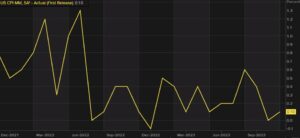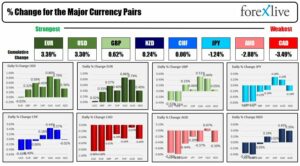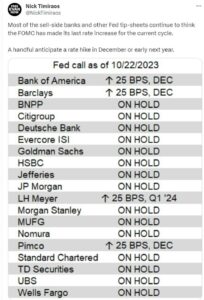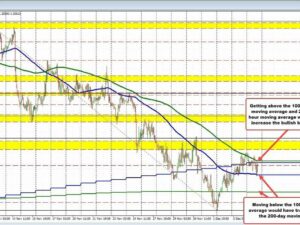
BoJ Noguchi reiterated the central bank’s focus on wage growth to reach their 2% target sustainably with no policy change in sight:
- It's true the impact of elevated global inflation is reaching Japan's economy with consumer inflation exceeding the BoJ's 2% target since the spring of 2022.
- But the rise (in inflation) is mostly due to cost-push factors amid higher import prices.
- To achieve our 2% inflation target, we must see price rises backed by sustained wage increases.
- While annual spring wage negotiations this year achieved wage hikes unseen in 30 years, we've only just reached a stage where the possibility of achieving our target has come into sight.
BoJ Noguchi
The Switzerland November CPI missed expectations with both the measures comfortably in the SNB’s 0-2% target range:
- CPI Y/Y 1.4% vs. 1.7% expected and 1.7% prior.
- CPI M/M -0.2% vs. -0.1% expected and 0.1% prior.
- Core CPI Y/Y 1.4% vs. 1.5% prior.
Switzerland CPI YoY
ECB’s de Guindos (neutral – voter) maintained his neutral stance as the central bank keeps a “wait and see” approach:
- Recent inflation data is good news.
- It's been a 'positive surprise'.
- But it is too early to declare victory.
- Increase in wages can still have an impact on inflation.
- Monetary policy stance will be data dependent.
ECB's de Guindos
The Tokyo CPI for November fell further:
- CPI Y/Y 2.6% vs. 3.3% prior.
- Core CPI Y/Y 2.3% vs. 2.4% expected and 2.7% prior.
- Core-Core CPI Y/Y 2.7% vs. 2.7% prior.
Tokyo Core-Core CPI YoY
The Chinese Caixin Services PMI for November beat expectations:
- Caixin Services PMI 51.5 vs. 50.8 expected and 50.4 prior.
Key points from the report:
- Business activity and new orders increase at quickest rates in three months.
- Confidence around the year-ahead improves.
- Inflationary pressures weaken.
China Caixin Services PMI
The RBA left the cash rate unchanged at 4.35% as expected with a slightly dovish tone:
- Whether further tightening of monetary policy is required to ensure that inflation returns to target in a reasonable timeframe will depend upon the data and the evolving assessment of risks.
- Board remains resolute in its determination to return inflation to target.
- The limited information received on the domestic economy since the November meeting has been broadly in line with expectations.
- Outlook for household consumption also remains uncertain.
- The monthly CPI indicator for October suggested that inflation is continuing to moderate, driven by the goods sector; the inflation update did not, however, provide much more information on services inflation.
- Measures of inflation expectations remain consistent with the inflation target.
- Conditions in the labour market also continued to ease gradually, although they remain tight.
- Domestically, there are uncertainties regarding the lags in the effect of monetary policy.
- Higher interest rates are working to establish a more sustainable balance between aggregate supply and demand in the economy.
- Holding the cash rate steady at this meeting will allow time to assess the impact of the increases in interest rates on demand, inflation and the labour market.
RBA
The Eurozone PPI for October came in line with expectations:
- PPI Y/Y -9.4% vs. -9.5% expected and -12.4% prior.
- PPI M/M 0.2% vs. 0.2% expected and 0.5% prior.
Eurozone PPI YoY
ECB’s Schnabel (hawk – voter) changed her tone to a more neutral stance after the latest inflation report:
- Further rate hikes "rather unlikely" after latest inflation data.
- Inflation developments are encouraging, fall in core prices remarkable.
- Must be careful about guiding policy for many months out.
- Current level of restriction is sufficient, has increased confidence 2% target will be met in 2025.
- But must not declare victory prematurely.
- Inflation is on the right track, but more progress is needed.
- No prolonged recession is seen.
- Data suggests economy may be bottoming out.
ECB's Schnabel
The US ISM Services PMI for November beat expectations:
- ISM Services PMI 52.7 vs. 52.0 expected and 51.8 prior.
- Employment index 50.7 vs. 50.2 prior.
- New orders index 55.5 vs. 55.5 prior.
- Prices paid index 58.3 vs. 58.6 prior.
- New export orders 53.6 vs. 48.8 prior.
- Imports 53.7 vs. 60.0 prior.
US ISM Services PMI
The US Job Openings for October missed expectations by a big margin with a negative revision to the prior reading:
- Job Openings 8.733M vs. 9.300M expected and 9.350M prior (revised from 9.553M).
- Hires 3.7% vs. 3.7% prior.
- Separations rate 3.6% vs. 3.6% prior.
- Quits 2.3% vs. 2.3% prior.
US Job Openings
The Australian Q3 GDP missed expectations:
- GDP Q/Q 0.2% vs. 0.4% expected and 0.4% prior.
- GDP Y/Y 2.1% vs. 1.8% expected and 2.1% prior.
Australia Q3 GDP
BoJ’s Himino just echoed the other members’ comments with the usual focus on wage growth:
- BoJ will patiently maintain easy policy until sustained, stable achievement of price target is in sight.
- Japan's financial system is likely resilient enough to weather stress from transition to higher interest rates.
- If we do not get the timing exit procedures wrong, the impact of a positive wage-inflation cycle will likely benefit wide range of households, companies.
- Must make appropriate decision on exit timing, procedure by scrutinising wage, inflation developments.
- BoJ must achieve situation where inflation slows ahead, but not too much.
- Japan is seeing steadily changes in price, wage behaviour.
- Solid progress is observed in the transformation of firms' wage- and price-setting behaviour.
- Price rises beginning to affect wages.
- Pass-through from wages to inflation is also returning somewhat.
- Without virtuous cycle between wages and prices, Japan will most likely revert to the deflationary state in the past.
- When Japan returns to an economy with positive interest rate, that could improve households' balance as a whole.
- If inflation expectations have heightened, that would mean impact of rise in real interest rate could be smaller than that of nominal rate.
BoJ Himino
The Eurozone Retail Sales for October missed expectations:
- Retail Sales M/M 0.1% vs. 0.2% expected and -0.1% prior (revised from -0.3%).
- Retail Sales Y/Y -1.2% vs. -1.1% expected and -2.9% prior.
Eurozone Retail Sales YoY
BoE’s Bailey (neutral – voter) reaffirmed the central bank’s “wait and see” approach:
- Outlook for inflation is uncertain.
- Rates likely to need to remain around current levels.
- We remain vigilant to financial stability risks that might arise.
BoE's Governor Bailey
ECB’s Kazimir (hawk – voter) pushed back against markets’ rate cuts expectations:
- Further rate hike is unlikely to be needed but market bets for Q1 rate cut are science fiction.
ECB's Kazimir
The US ADP missed expectations:
- ADP 103K vs. 130K expected and 106K prior (revised from 113K).
Details:
- Small (less than 50 employees) 6K vs. 19K prior.
- Medium firms (500 – 499) 68K vs. 78K prior.
- Large (greater than 499 employees) 33K vs. 18K prior.
Changes in pay:
- Job stayers 5.6% vs. 5.7% prior - slowest since September 2021.
- Job changers 8.3% vs. 8.4% prior.
US ADP
The BoC left interest rates unchanged at 5.00% as expected:
- Statement repeats that BoC "is prepared to raise the policy rate further if needed".
- Data "suggest the economy is no longer in excess demand".
- BoC saw "further signs that monetary policy is moderating spending and relieving price pressures".
- The slowdown in the economy is reducing inflationary pressures in a broadening range of goods and services prices.
- Governing Council wants to see further and sustained easing in core inflation.
- The global economy continues to slow, and inflation has eased further.
- US growth has been stronger than expected but is likely to weaken in the months ahead.
- Growth in the euro area has weakened.
- Oil prices are about $10-per-barrel lower than was assumed in the October MPR.
- The US dollar has weakened against most currencies, including Canada’s.
- Higher interest rates are clearly restraining spending: consumption growth in the last two quarters was close to zero.
- The labour market continues to ease: job creation has been slower than labour force growth.
BoC
ECB’s Villeroy (neutral – voter) reaffirmed that the central bank is done with rate hikes and the next step is rate cuts in 2024:
- Disinflation is happening more quickly than we thought.
- This is why, barring any shocks, there will not be any new rise in rates. The question of a rate cut could arise in 2024, but not right now.
ECB's Villeroy
BoJ Governor Ueda didn’t say anything explicitly about an exit from the current easy policy BUT you can clearly read between the lines that they are considering rate hikes:
- Japan's economy to continue recovering moderately, supported mainly by accommodative financial conditions and effects of economic stimulus measures.
- Uncertainty over Japan’s economy extremely high.
- Closely watching the impact of financial, forex markets on the Japanese economy, prices.
- Will patiently continue monetary easing under YCC to support economic activity, cycle of wage growth.
- We have not yet reached a situation in which we can achieve price target sustainably and stably and with sufficient certainty.
- Challenging situation remains.
- It'll become even more challenging towards the end of this year and into early 2024.
- BoJ has not made decision on which interest rate to target once we end negative interest rate policy.
- Options include raising rate applied to financial institutions' reserves at BoJ, or revert to policy targeting overnight call rate.
- Don't have any specific idea in mind on how much we will raise rates once we end negative rate policy.
- Whether to keep interest rate at zero or move it up to 0.1%, and at what pace short-term rates will be hiked after ending negative rate policy, will depend on economic and financial developments at the time.
- Achieving 2% trend inflation can be defined as a state where economy, void of new shocks, can see inflation sustained around 2% and wage growth somewhat above that level.
- Would be difficult to choose which monetary policy tools to mobilise when exit from stimulus draws near.
- BoJ to work closely with govt while monitoring currency, financial market moves.
- Service spending increasing moderately as a trend.
- What's important from here is for wages to keep rising and underpin consumption.
BoJ Governor Ueda
The Switzerland Unemployment Rate for November ticked higher to 2.1% vs. 2.0% prior, while the Seasonally adjusted unemployment rate remained unchanged at 2.1% vs. 2.2% expected.
Switzerland Unemployment Rate
The US Challenger Job Cuts for November increased to 45.51K vs. 36.84K prior. Compared to the same month last year, job cuts are down by roughly 41% but then again there was an exceptional number of tech layoffs in November of 2022. The 45.51K layoffs last month brings the year-to-date total to 686,860 and that's roughly a 115% increase to the year-to-date total for last year through to November.
US Challenger Job Cuts
The US Jobless Claims beat expectations across the board:
- Initial Claims 220K vs. 222K expected and 219K prior (revised from 218K).
- Continuing Claims 1861K vs. 1910K expected and 1925K prior (revised from 1927K).
US Jobless Claims
BoC’s Gravelle acknowledged the progress on inflation:
- Gravelle noted that housing imbalances have serious consequences for shelter price inflation, contributing 1.8 percentage points to the total October inflation rate of 3.1%.
- Emphasized the need for Canada to have more homes and a housing supply that is more responsive to increases in demand.
- Pointed out that a jump in demographic demand, coupled with existing structural supply issues, could explain why rent inflation continues to climb.
- Stressed the importance of all levels of government working together on housing policies to boost supply.
- Urged the reduction of barriers to adding capacity and ensuring market flexibility to meet future changes in housing demand.
- Warned that without more house building, inflationary pressures in the shelter sector could continue to build.
- Highlighted that rent inflation reached a 40-year high in October, with housing supply not keeping pace with recent increases in immigration.
- Reported that housing activity grew 8.3% in Q3 but remains far below the level needed to meet growing housing needs.
- Commented that recent increases in immigration have boosted near-term consumption but haven't significantly affected inflation.
- Noted that the economy is now roughly in balance, with a focus on monitoring inflation expectations, wage growth, and corporate pricing behaviour.
- Stressed the importance of indicators in assessing whether inflation is on a sustained path to the 2% target.
- Said that the market has been relatively right on their previous two or three decisions, so it seems like it’s taking in the data in the same way they are.
BoC's Gravelle
The Japanese Average Cash Earnings increased in October on a year-over-year basis marking the 22nd consecutive month of rising wages:
- Average Cash Earnings Y/Y 1.5% vs. 0.6% prior (revised from 1.2%).
- Real wages Y/Y -2.3%.
Japan Average Cash Earnings YoY
The US NFP report beat expectations across the board by a big margin:
- NFP 199K vs. 180K expected and 150K prior.
- Two-month net revision -35K vs -101K prior.
- Unemployment rate 3.7% vs. 3.9% expected and 3.9% prior.
- Participation rate 62.8% vs. 62.7% prior.
- U6 underemployment rate 7.0% vs. 7.2% prior.
- Average hourly earnings M/M 0.4% vs. 0.3% expected and 0.2% prior.
- Average hourly earnings Y/Y 4.0% vs. 4.1% expected and 4.0% prior (revised from 4.1%).
- Average weekly hours 34.4 vs. 34.3 expected and 34.3 prior.
- Change in private payrolls 150K vs. 153K expected.
- Change in manufacturing payrolls 28K vs. 30K expected.
- Household survey 747K vs. -348K prior.
- Birth-death adjustment 4K vs. 412K prior.
US Unemployment Rate
The highlights for next week will be:
- Tuesday: Japan PPI, UK Labour Market report, NFIB Small Business Optimism Index, US CPI.
- Wednesday: UK GDP, Eurozone Industrial Production, US PPI, FOMC Policy Decision, New Zealand GDP.
- Thursday: Australia Labour Market report, SNB Policy Decision, BoE Policy Decision, ECB Policy Decision, US Retail Sales, US Jobless Claims, New Zealand Manufacturing PMI.
- Friday: Australia/Japan/Eurozone/UK/US Flash PMIs, China Industrial Production and Retail Sales, Eurozone Wage data, US Industrial Production, PBoC MLF.
That’s all folks. Have a nice weekend!
- SEO Powered Content & PR Distribution. Get Amplified Today.
- PlatoData.Network Vertical Generative Ai. Empower Yourself. Access Here.
- PlatoAiStream. Web3 Intelligence. Knowledge Amplified. Access Here.
- PlatoESG. Carbon, CleanTech, Energy, Environment, Solar, Waste Management. Access Here.
- PlatoHealth. Biotech and Clinical Trials Intelligence. Access Here.
- Source: https://www.forexlive.com/news/weekly-market-recap-04-08-december-20231208/
- :has
- :is
- :not
- :where
- $UP
- 1
- 18k
- 2%
- 2% Inflation
- 2021
- 2022
- 2024
- 2025
- 220K
- 26
- 30
- 35%
- 36
- 4k
- 50
- 500
- 51
- 52
- 53
- 58
- 60
- 7
- 8
- 9
- a
- About
- above
- Achieve
- achieved
- achievement
- achieving
- acknowledged
- across
- activity
- adding
- Adjusted
- Adjustment
- adp
- affect
- affected
- After
- again
- against
- aggregate
- ahead
- All
- allow
- also
- Although
- Amid
- an
- and
- annual
- any
- anything
- applied
- approach
- appropriate
- ARE
- AREA
- arise
- around
- AS
- assess
- Assessing
- assessment
- assumed
- At
- Australia
- Australian
- average
- back
- backed
- BAILeY
- Balance
- Bank
- barriers
- basis
- BE
- beat
- become
- been
- Beginning
- behaviour
- below
- benefit
- Bets
- between
- Big
- board
- BoC
- BoE
- boj
- boost
- Boosted
- both
- Brings
- broadly
- build
- Building
- business
- but
- by
- call
- came
- CAN
- Canada
- Capacity
- careful
- Cash
- central
- Central Bank
- certainty
- challenger
- challenging
- change
- changed
- Changes
- China
- chinese
- Choose
- claims
- clearly
- climb
- Close
- closely
- come
- comments
- Companies
- compared
- conditions
- confidence
- consecutive
- Consequences
- considering
- consistent
- consumer
- consumption
- continue
- continued
- continues
- continuing
- contributing
- Core
- core inflation
- Corporate
- could
- Council
- coupled
- CPI
- creation
- currencies
- Currency
- Current
- Cut
- cuts
- cycle
- data
- December
- decision
- decisions
- defined
- deflationary
- Demand
- demographic
- depend
- dependent
- determination
- developments
- DID
- difficult
- do
- Dollar
- Domestic
- done
- Dovish
- down
- draws
- driven
- due
- Early
- Earnings
- ease
- easing
- easy
- ECB
- ECB policy decision
- echoed
- Economic
- economy
- effect
- effects
- elevated
- employees
- encouraging
- end
- ending
- enough
- ensure
- ensuring
- establish
- Euro
- Eurozone
- Even
- evolving
- exceptional
- excess
- existing
- Exit
- expectations
- expected
- Explain
- explicitly
- export
- extremely
- factors
- Fall
- far
- Fiction
- financial
- Financial institutions
- Financial Market
- financial stability
- firms
- Flash
- Flexibility
- Focus
- FOMC
- For
- Force
- forex
- Forex markets
- from
- further
- future
- GDP
- get
- Global
- Global economy
- good
- goods
- Government
- Governor
- Govt
- greater
- grew
- Growing
- Growth
- Happening
- Have
- haven
- Hawk
- heightened
- her
- here
- High
- higher
- highlights
- Hike
- Hikes
- his
- Homes
- HOURS
- House
- household
- households
- housing
- How
- However
- HTTPS
- idea
- if
- immigration
- Impact
- import
- importance
- important
- improve
- improves
- in
- include
- Including
- Increase
- increased
- Increases
- increasing
- index
- Indicator
- Indicators
- industrial
- Industrial Production
- inflation
- Inflation expectations
- inflation rate
- Inflationary
- Inflationary pressures
- information
- institutions
- interest
- INTEREST RATE
- Interest Rates
- into
- issues
- IT
- ITS
- Japan
- Japan PPI
- Japan’s
- Japanese
- Job
- job cuts
- jobless claims
- jpg
- jump
- just
- Keep
- keeping
- Labour
- Last
- Last Year
- latest
- layoffs
- left
- less
- Level
- levels
- like
- likely
- Limited
- Line
- lines
- ll
- longer
- lower
- made
- mainly
- maintain
- make
- manufacturing
- many
- Margin
- Market
- market moves
- Market Report
- Markets
- marking
- May..
- mean
- measures
- Meet
- meeting
- met
- might
- mind
- missed
- MLF
- moderate
- Monetary
- Monetary Policy
- monitoring
- Month
- monthly
- months
- more
- most
- mostly
- move
- moves
- much
- must
- Near
- Need
- needed
- needs
- negative
- negotiations
- net
- Neutral
- New
- New Zealand
- New Zealand GDP
- New Zealand Manufacturing PMI
- news
- next
- next week
- nfp
- nice
- no
- noted
- November
- now
- number
- observed
- october
- of
- on
- once
- only
- openings
- Optimism
- or
- orders
- Other
- our
- out
- over
- overnight
- Pace
- paid
- past
- path
- patiently
- Pay
- Payrolls
- PBOC
- PBOC MLF
- percentage
- plato
- Plato Data Intelligence
- PlatoData
- pmi
- points
- policies
- policy
- positive
- possibility
- ppi
- prepared
- previous
- price
- Prices
- pricing
- Prior
- private
- procedure
- procedures
- Production
- Progress
- provide
- pushed
- Q1
- Q3
- question
- quickest
- quickly
- raise
- raising
- range
- Rate
- Rate Hike
- rate hikes
- Rates
- rather
- RBA
- reach
- reached
- reaching
- Read
- Reading
- reaffirmed
- real
- reasonable
- recap
- received
- recent
- recession
- recovering
- reducing
- reduction
- regarding
- relatively
- remain
- remained
- remains
- remarkable
- Rent
- report
- required
- reserves
- resilient
- responsive
- restriction
- retail
- Retail Sales
- return
- returning
- returns
- revert
- right
- Rise
- Rises
- rising
- risks
- roughly
- s
- sales
- same
- saw
- say
- Science
- sector
- see
- seeing
- seems
- seen
- September
- serious
- Services
- Shelter
- short-term
- Sight
- significantly
- Signs
- since
- situation
- slow
- Slowdown
- slows
- small
- smaller
- SNB
- So
- somewhat
- specific
- Spending
- spring
- Stability
- stable
- Stage
- stance
- State
- steadily
- steady
- Step
- Still
- stimulus
- stress
- stronger
- structural
- sufficient
- suggest
- Suggests
- supply
- Supply and Demand
- support
- Supported
- surprise
- Survey
- sustainable
- sustainably
- sustained
- switzerland
- system
- T
- taking
- Target
- targeting
- tech
- than
- that
- The
- their
- then
- There.
- they
- this
- this year
- thought
- three
- Through
- tightening
- time
- timeframe
- timing
- to
- together
- tokyo
- Tokyo CPI
- TONE
- too
- tools
- Total
- towards
- track
- Transformation
- transition
- Trend
- true
- two
- Uk
- UK GDP
- uk labour market
- Uncertain
- uncertainties
- under
- underpin
- unemployment
- unemployment rate
- unlikely
- until
- Update
- upon
- us
- US CPI
- US Dollar
- US job openings
- US Jobless Claims
- us NFP
- US PPI
- US Retail Sales
- usual
- Ve
- victory
- Voter
- vs
- wage
- wages
- wants
- was
- watching
- Way..
- we
- Weather
- week
- weekly
- What
- when
- whether
- which
- while
- whole
- why
- wide
- Wide range
- will
- with
- without
- Work
- working
- would
- Wrong
- year
- years
- yet
- you
- Zealand
- zephyrnet
- zero










